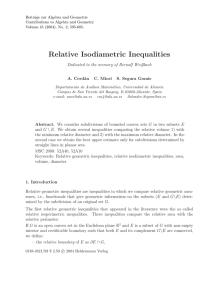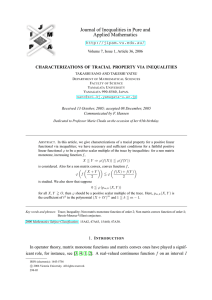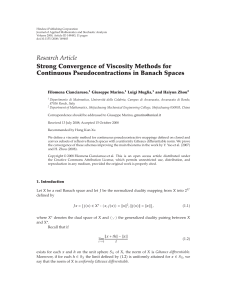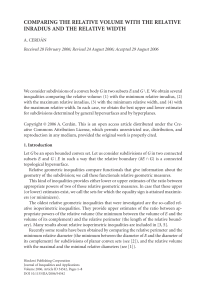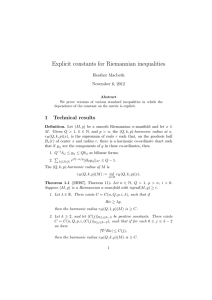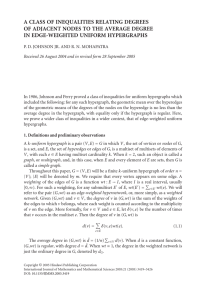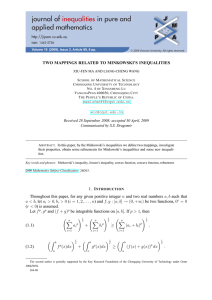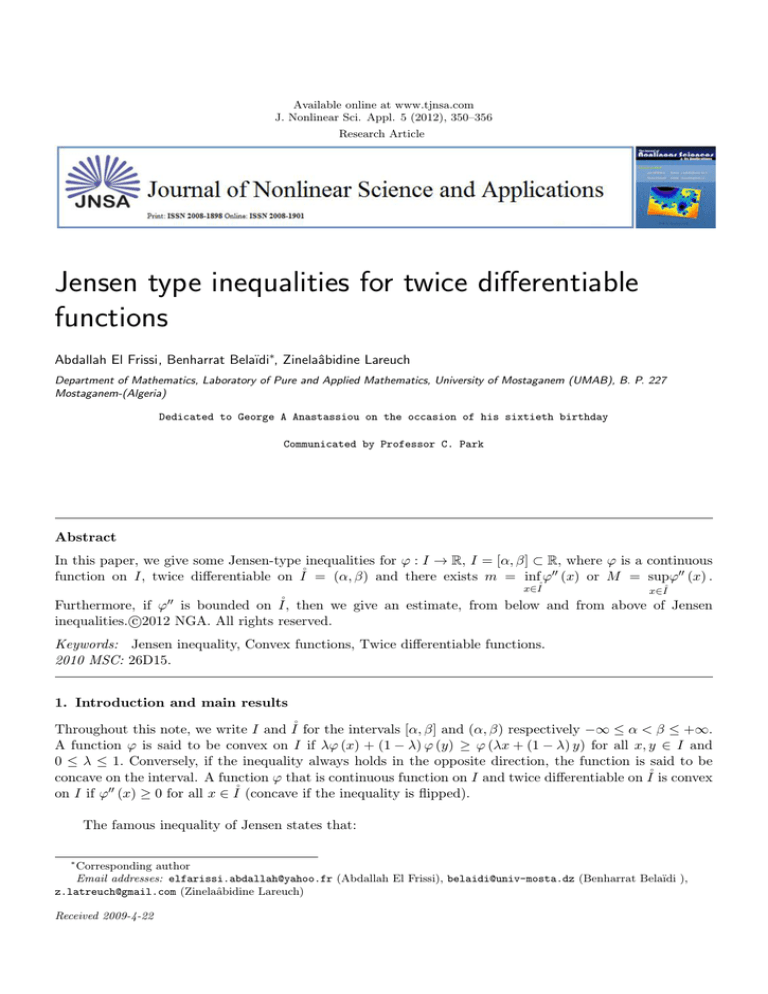
Available online at www.tjnsa.com
J. Nonlinear Sci. Appl. 5 (2012), 350–356
Research Article
Jensen type inequalities for twice differentiable
functions
Abdallah El Frissi, Benharrat Belaı̈di∗, Zinelaâbidine Lareuch
Department of Mathematics, Laboratory of Pure and Applied Mathematics, University of Mostaganem (UMAB), B. P. 227
Mostaganem-(Algeria)
Dedicated to George A Anastassiou on the occasion of his sixtieth birthday
Communicated by Professor C. Park
Abstract
In this paper, we give some Jensen-type inequalities for ϕ : I → R, I = [α, β] ⊂ R, where ϕ is a continuous
function on I, twice differentiable on ˚
I = (α, β) and there exists m = inf ϕ00 (x) or M = supϕ00 (x) .
x∈˚
I
x∈˚
I
Furthermore, if
is bounded on ˚
I, then we give an estimate, from below and from above of Jensen
c
inequalities.2012
NGA. All rights reserved.
ϕ00
Keywords: Jensen inequality, Convex functions, Twice differentiable functions.
2010 MSC: 26D15.
1. Introduction and main results
Throughout this note, we write I and ˚
I for the intervals [α, β] and (α, β) respectively −∞ ≤ α < β ≤ +∞.
A function ϕ is said to be convex on I if λϕ (x) + (1 − λ) ϕ (y) ≥ ϕ (λx + (1 − λ) y) for all x, y ∈ I and
0 ≤ λ ≤ 1. Conversely, if the inequality always holds in the opposite direction, the function is said to be
concave on the interval. A function ϕ that is continuous function on I and twice differentiable on ˚
I is convex
on I if ϕ00 (x) ≥ 0 for all x ∈ ˚
I (concave if the inequality is flipped).
The famous inequality of Jensen states that:
∗
Corresponding author
Email addresses: elfarissi.abdallah@yahoo.fr (Abdallah El Frissi), belaidi@univ-mosta.dz (Benharrat Belaı̈di ),
z.latreuch@gmail.com (Zinelaâbidine Lareuch)
Received 2009-4-22
A. El Farissi, B. Belaı̈di, Z. Lareuch, J. Nonlinear Sci. Appl. 5 (2012), 350–356
351
Theorem 1.1. ([1], [3]) Let ϕ be a convex P
function on the interval I ⊂ R, x = (x1 , x2 , · · · , xn ) ∈ I n
(n ≥ 2), let pi ≥ 0, i = 1, 2, · · · , n and Pn = ni=1 pi . Then
!
n
n
1 X
1 X
ϕ
p i xi ≤
pi ϕ (xi ) .
(1.1)
Pn
Pn
i=1
i=1
If ϕ is strictly convex, then inequality in (1.1) is strict except when x1 = x2 = · · · = xn . If ϕ is a concave
function, then inequality in (1.1) is reverse.
Theorem 1.2. [3] Let ϕ be a convex function on I ⊂ R, and let f : [0, 1] −→ I be a continuous function on
[0, 1]. Then
Z 1
Z 1
ϕ (f (x)) dx.
(1.2)
ϕ
f (x) dx ≤
0
0
If ϕ is strictly convex, then inequality in (1.2) is strict. If ϕ is a concave function, then inequality in (1.2)
is reverse.
In [2], Malamud gave some complements to the Jensen and Chebyshev inequalities and in [4], Saluja
gave some necessary and sufficient conditions for three-step iterative sequence with errors for asymptotically
quasi-nonexpansive type mapping converging to a fixed point in convex metric spaces. In this paper, we
give some inequalities of the above type for ϕ : I → R such that ϕ is a continuous on I, twice differentiable
on ˚
I and there exists m = inf ϕ00 (x) or M = supϕ00 (x) . We obtain the following results:
x∈˚
I
x∈˚
I
Theorem 1.3. Let ϕ : I −→ R be a continuous function
on I, twice differentiable on ˚
I, x = (x1 , x2 , · · · , xn ) ∈
Pn
n
I (n ≥ 2), let pi ≥ 0, i = 1, 2, · · · , n and Pn = i=1 pi .
(i) If there exists m = inf ϕ00 (x), then
x∈˚
I
n
1 X
pi ϕ (xi ) − ϕ
Pn
i=1
n
m 1 X
≥
pi x2i −
2 Pn
i=1
n
1 X
p i xi
Pn
!
i=1
n
1 X
p i xi
Pn
!2
.
(1.3)
i=1
(ii) If there exists M = supϕ00 (x) , then
x∈˚
I
n
1 X
pi ϕ (xi ) − ϕ
Pn
i=1
n
M 1 X
pi x2i −
≤
2
Pn
i=1
n
1 X
p i xi
Pn
!
i=1
n
1 X
p i xi
Pn
!2
.
(1.4)
i=1
Equality in (1.3) and (1.4) hold if x1 = x2 = · · · = xn or if ϕ (x) = αx2 + βx + γ, α, β, γ ∈ R.
Theorem 1.4. Let ϕ : I −→ R be a continuous function on I, twice differentiable on ˚
I. Suppose that
f : [a, b] −→ I and p : [a, b] −→ R+ are continuous functions on [a, b] .
(i) If there exists m = inf ϕ00 (x), then
x∈˚
I
Rb
a
p (x) ϕ (f (x)) dx
−ϕ
Rb
a p (x) dx
Rb
a p (x) f (x) dx
Rb
a p (x) dx
!
A. El Farissi, B. Belaı̈di, Z. Lareuch, J. Nonlinear Sci. Appl. 5 (2012), 350–356
R
b
2
m a p (x) (f (x)) dx
≥
−
Rb
2
p (x) dx
Rb
a p (x) f (x) dx
Rb
a p (x) dx
a
(ii) If there exists M =
supϕ00 (x),
352
!2
.
(1.5)
then
x∈˚
I
Rb
Rb
a
a
p (x) ϕ (f (x)) dx
−ϕ
Rb
a p (x) dx
R
b
2
M a p (x) (f (x)) dx
≤
−
Rb
2
a p (x) dx
p (x) f (x) dx
Rb
a p (x) dx
Rb
a
!
p (x) f (x) dx
Rb
a p (x) dx
!2
.
(1.6)
Equality in (1.5) and (1.6) hold if ϕ (x) = αx2 + βx + γ, α, β, γ ∈ R.
Corollary 1.5. Let ϕ : I −→ R be a continuous function on I, twice differentiable on ˚
I and let f : [a, b] −→
I be a continuous function on [a, b] .
(i) If there exists m = inf ϕ00 (x), then
x∈˚
I
1
b−a
m
≥
2
b
Z
ϕ (f (x)) dx − ϕ
a
1
b−a
b
Z
1
b−a
(f (x))2 dx −
b
Z
a
1
b−a
Z
1
b−a
Z
a
f (x) dx
2 !
b
f (x) dx
.
(1.7)
.
(1.8)
a
(ii) If there exists M = supϕ00 (x), then
x∈˚
I
1
b−a
M
≤
2
b
Z
ϕ (f (x)) dx − ϕ
a
1
b−a
Z
b
(f (x))2 dx −
a
1
b−a
b
f (x) dx
a
Z
2 !
b
f (x) dx
a
Equality in (1.7) and (1.8) hold if ϕ (x) = αx2 + βx + γ, α, β, γ ∈ R.
Corollary 1.6. Let ϕ : I −→ R be a continuous function
on I, twice differentiable on ˚
I, x = (x1 , x2 , · · · , xn ) ∈
Pn
n
00
I (n ≥ 2), let pi ≥ 0, i = 1, 2, · · · , n and Pn = i=1 pi . If there exist m = inf ϕ (x) and M = supϕ00 (x),
x∈˚
I
then we have
n
m 1 X
pi x2i −
2 Pn
i=1
n
1 X
pi xi
Pn
i=1
!
n
n
1 X
1 X
≤
pi ϕ (xi ) − ϕ
p i xi
Pn
Pn
i=1
i=1
!2
n
n
X
X
M 1
1
≤
pi x2i −
p i xi .
2
Pn
Pn
i=1
x∈˚
I
!2
i=1
Equality in (1.9) occurs, if ϕ (x) = αx2 + βx + γ, α, β, γ ∈ R.
(1.9)
A. El Farissi, B. Belaı̈di, Z. Lareuch, J. Nonlinear Sci. Appl. 5 (2012), 350–356
353
Corollary 1.7. Let ϕ : I −→ R be a continuous function on I, twice differentiable on ˚
I, and let f : [0, 1] −→
00
00
I be a continuous function on [0, 1] . If there exist m = inf ϕ (x) and M = supϕ (x), then we have
x∈˚
I
1
Z
m
2
(f (x))2 dx −
2 !
1
Z
f (x) dx
0
0
1
Z
x∈˚
I
1
Z
ϕ (f (x)) dx − ϕ
≤
f (x) dx
0
0
1
Z
M
≤
2
Z
2
2 !
1
(f (x)) dx −
f (x) dx
0
.
(1.10)
0
Equality in (1.10) holds if ϕ (x) = αx2 + βx + γ
α, β, γ ∈ R.
Corollary 1.8. Let ϕ : I −→ R be a convex function on I, twice differentiable on ˚
I, and let f : [a, b] −→ I
be a continuous function on [a, b] . If there exists m = inf ϕ00 (x) , then
x∈˚
I
1
b−a
m
≥
2
and
b
Z
ϕ (f (x)) dx − ϕ
a
b
Z
1
b−a
2
(f (x)) dx −
a
1
b−a
1
b−a
b
Z
f (x) dx
a
2 !
b
Z
≥0
f (x) dx
!
n
n
1 X
1 X
pi ϕ (xi ) − ϕ
p i xi
Pn
Pn
i=1
i=1
!2
n
n
X
X
m 1
1
≥
pi x2i −
pi xi ≥ 0.
2 Pn
Pn
i=1
(1.11)
a
(1.12)
i=1
Corollary 1.9. Let ϕ : I −→ R be a concave function on I, twice differentiable on ˚
I, and let f : [a, b] −→ I
00
be a continuous function on [a, b]. If there exists M = supϕ (x) , then
x∈˚
I
1
b−a
M
≤
2
and
b
Z
ϕ (f (x)) dx − ϕ
a
1
b−a
Z
b
2
(f (x)) dx −
a
1
b−a
1
b−a
b
Z
f (x) dx
a
Z
2 !
b
f (x) dx
!
n
n
1 X
1 X
pi ϕ (xi ) − ϕ
p i xi
Pn
Pn
i=1
i=1
!2
n
n
X
X
M 1
1
≤
pi x2i −
pi xi ≤ 0.
2
Pn
Pn
i=1
≤0
(1.13)
a
(1.14)
i=1
Remark 1.10. In the above if ϕ ∈ C 2 ([α, β]) , then we can replace inf and sup by min and max respectively.
A. El Farissi, B. Belaı̈di, Z. Lareuch, J. Nonlinear Sci. Appl. 5 (2012), 350–356
354
2. Lemma
Our proofs depend mainly upon the following lemma.
Lemma 2.1. Let ϕ be a convex function on I ⊂ R and differentiable on ˚
I. Suppose that f : [a, b] −→ I and
p : [a, b] −→ R+ are continuous functions on [a, b]. Then
! Rb
Rb
p
(x)
f
(x)
dx
p (x) ϕ (f (x)) dx
a
ϕ
≤ a Rb
.
(2.1)
Rb
a p (x) dx
a p (x) dx
If ϕ is strictly convex, then inequality in (2.1) is strict. If ϕ is a concave function, then inequality in (2.1)
is reverse.
Proof. Suppose that ϕ is a convex function on I ⊂ R and differentiable on ˚
I. Then for each x, y ∈ ˚
I, we
have
ϕ (x) − ϕ (y) ≥ (x − y) ϕ0 (y) .
(2.2)
Rb
Replace x by f (x) and set y =
a
p(x)f (x)dx
Rb
a p(x)dx
in (2.2), we obtain
Rb
ϕ (f (x)) − ϕ
Rb
≥
f (x) −
a
a p (x) f (x) dx
Rb
a p (x) dx
p (x) f (x) dx
Rb
a p (x) dx
Rb
!
0
a
ϕ
!
p (x) f (x) dx
Rb
a p (x) dx
!
.
(2.3)
Multiplying both sides of inequality (2.3) by p (x) we obtain
Rb
p (x) ϕ (f (x)) − p (x) ϕ
Rb
≥
a
p (x) f (x) − p (x)
a p (x) f (x) dx
Rb
a p (x) dx
p (x) f (x) dx
Rb
a p (x) dx
!
ϕ
0
Rb
a
!
p (x) f (x) dx
Rb
a p (x) dx
!
.
(2.4)
By integration in (2.4) we obtain (2.1).
3. Proof of the Theorems
Proof of Theorem 1.3. Suppose that ϕ : I → R is a continuous function on I and twice differentiable on
2
00
00
˚
I. Set g (x) = ϕ (x) − m
2 x . Differentiating twice times both sides of g we get g (x) = ϕ (x) − m ≥ 0. Then
g is a convex function on I. By formula (1.1), we have
!
n
n
1 X
1 X
g
pi xi ≤
pi g (xi )
(3.1)
Pn
Pn
i=1
i=1
which implies that
ϕ
n
1 X
p i xi
Pn
i=1
1
≤
Pn
n
X
i=1
!
m
−
2
n
1 X
pi xi
Pn
!2
i=1
n
m 1 X
pi ϕ (xi ) −
pi x2i .
2 Pn
i=1
(3.2)
A. El Farissi, B. Belaı̈di, Z. Lareuch, J. Nonlinear Sci. Appl. 5 (2012), 350–356
355
Then, by (3.2) we can write
!
n
n
1 X
1 X
pi ϕ (xi ) − ϕ
p i xi
Pn
Pn
i=1
i=1
!2
n
n
X
m 1 X
1
≥
pi x2i −
p i xi .
2 Pn
Pn
i=1
(3.3)
i=1
2
00
00
If we put g (x) = −ϕ (x) + M
2 x , then by differentiating both sides of g we get g (x) = −ϕ (x) + M ≥ 0.
Hence g is a convex function on I and by similar proof as above, we obtain
!
n
n
1 X
1 X
pi ϕ (xi ) − ϕ
p i xi
Pn
Pn
i=1
i=1
n
M 1 X
≤
pi x2i −
2
Pn
i=1
n
1 X
p i xi
Pn
!2
.
(3.4)
i=1
Proof of Theorem 1.4. Suppose that ϕ : I → R is a continuous function on I and twice differentiable on
2
00
00
˚
I. Set g (x) = ϕ (x) − m
2 x . Differentiating both sides of g we get g (x) = ϕ (x) − m ≥ 0. Hence g is a
convex function on I and by formula (2.1) we have
! Rb
Rb
p
(x)
f
(x)
dx
p (x) g (f (x)) dx
a
g
≤ a Rb
(3.5)
Rb
a p (x) dx
a p (x) dx
which implies that
Rb
a
ϕ
Rb
≤
a
p (x) f (x) dx
Rb
a p (x) dx
!
m
−
2
p (x) ϕ (f (x)) dx m
−
Rb
2
p
(x)
dx
a
Rb
a
Rb
a
p (x) f (x) dx
Rb
a p (x) dx
!2
p (x) (f (x))2 dx
.
Rb
p
(x)
dx
a
(3.6)
Then by (3.6), we can write
Rb
a p (x) ϕ (f (x)) dx
−ϕ
Rb
a p (x) dx
R
b
2
m a p (x) (f (x)) dx
≥
−
Rb
2
p (x) dx
a
Rb
!
Rb
!2
a p (x) f (x) dx
Rb
a p (x) dx
a p (x) f (x) dx
Rb
a p (x) dx
.
(3.7)
2
00
00
If we put g (x) = ϕ (x) − M
2 x , then by differentiating both sides of g, we get g (x) = ϕ (x) − M ≤ 0. Thus,
g is a concave function on I and by a similar proof as above, we obtain
!
Rb
Rb
a p (x) ϕ (f (x)) dx
a p (x) f (x) dx
−ϕ
Rb
Rb
p
(x)
dx
a
a p (x) dx
R
!2
Rb
b
2
M a p (x) (f (x)) dx
a p (x) f (x) dx
.
≤
−
(3.8)
Rb
Rb
2
p (x) dx
p (x) dx
a
a
A. El Farissi, B. Belaı̈di, Z. Lareuch, J. Nonlinear Sci. Appl. 5 (2012), 350–356
356
References
[1] I. Budimir, S. S. Dragomir and J. Pečarić, Further reverse results for Jensen’s discrete inequality and applications
in information theory, J. Inequal. Pure Appl. Math. 2 (2001), no. 1, Article 5, 1-14. 1.1
[2] S. M. Malamud, Some complements to the Jensen and Chebyshev inequalities and a problem of W. Walter, Proc.
Amer. Math. Soc. 129 (2001), no. 9, 2671–2678. 1
[3] D. S. Mitrinović, J. E. Pečarić and A. M. Fink, Classical and new inequalities in analysis. Mathematics and its
Applications (East European Series), 61. Kluwer Academic Publishers Group, Dordrecht, 1993. 1.1, 1.2
[4] G. S. Saluja, Convergence of fixed point of asymptoticaly quasi-nonexpansive type mappings in convex metric
spaces, J. Nonlinear Sci. Appl. 1 (2008), no. 3, 132-144. 1


